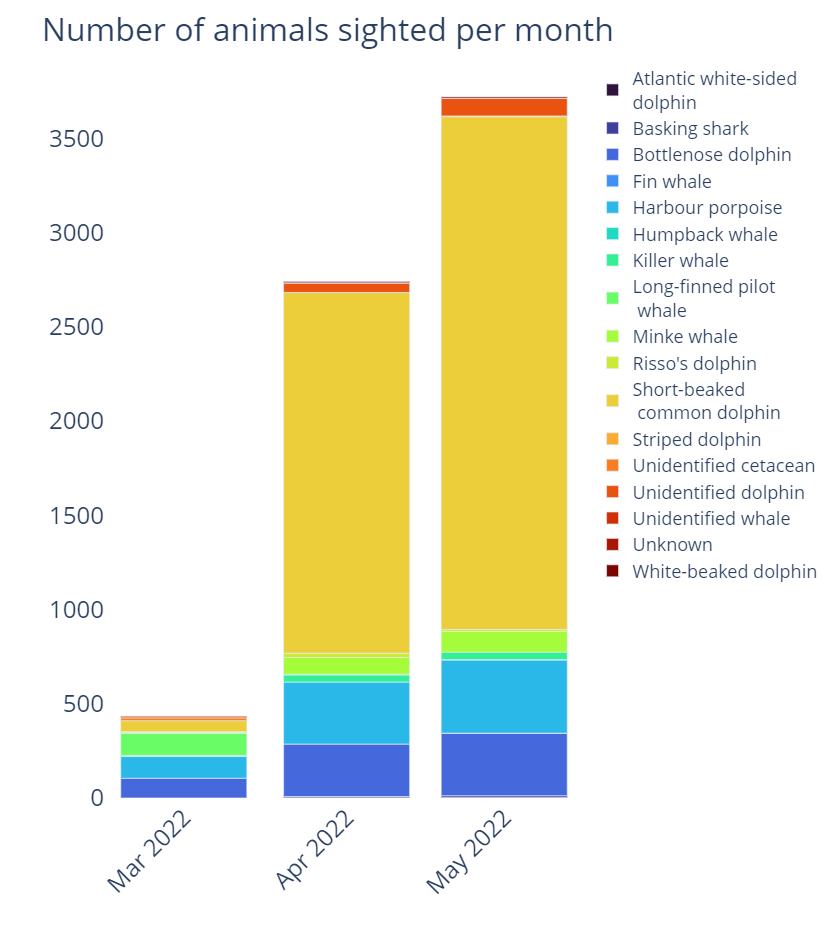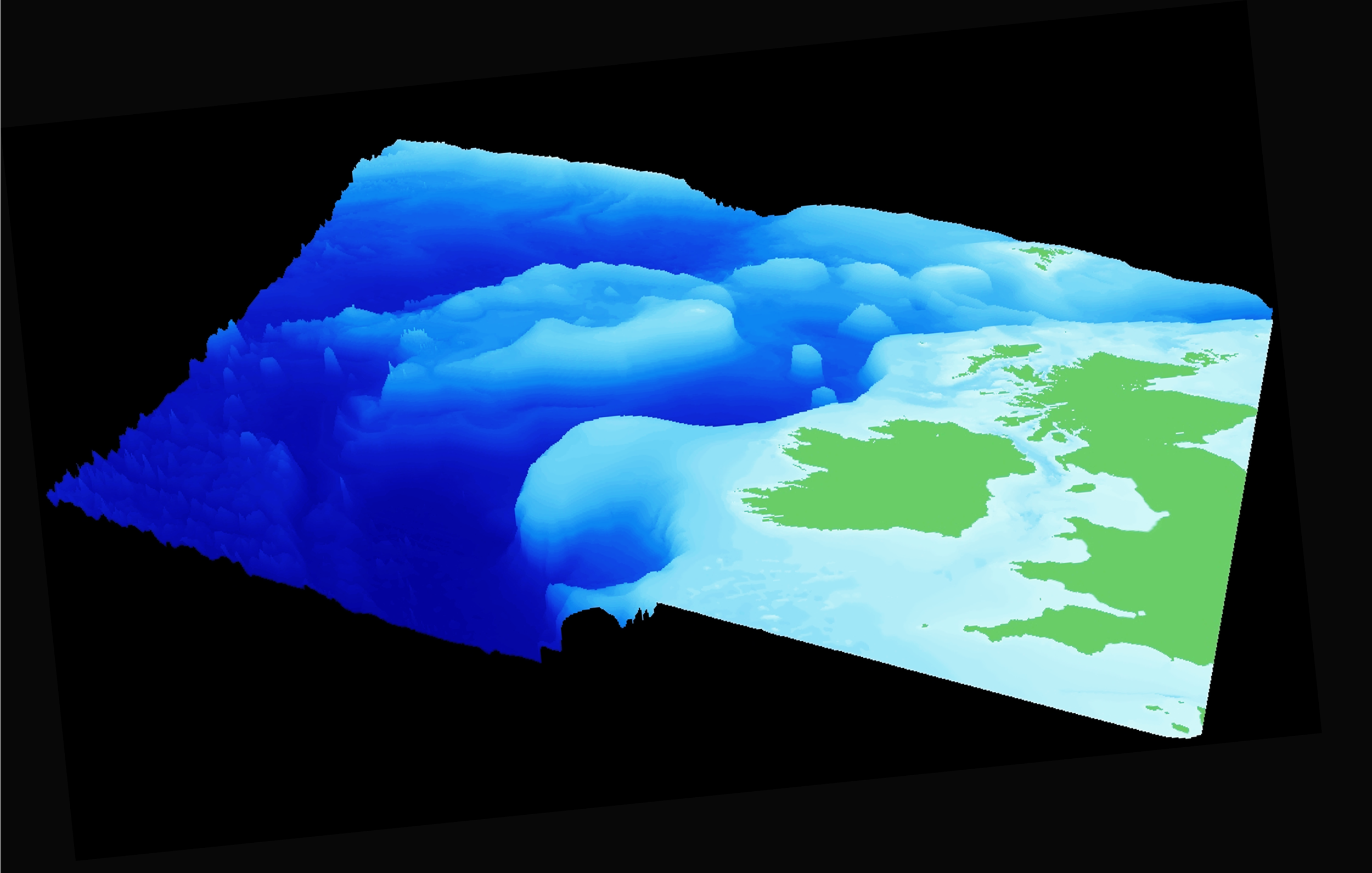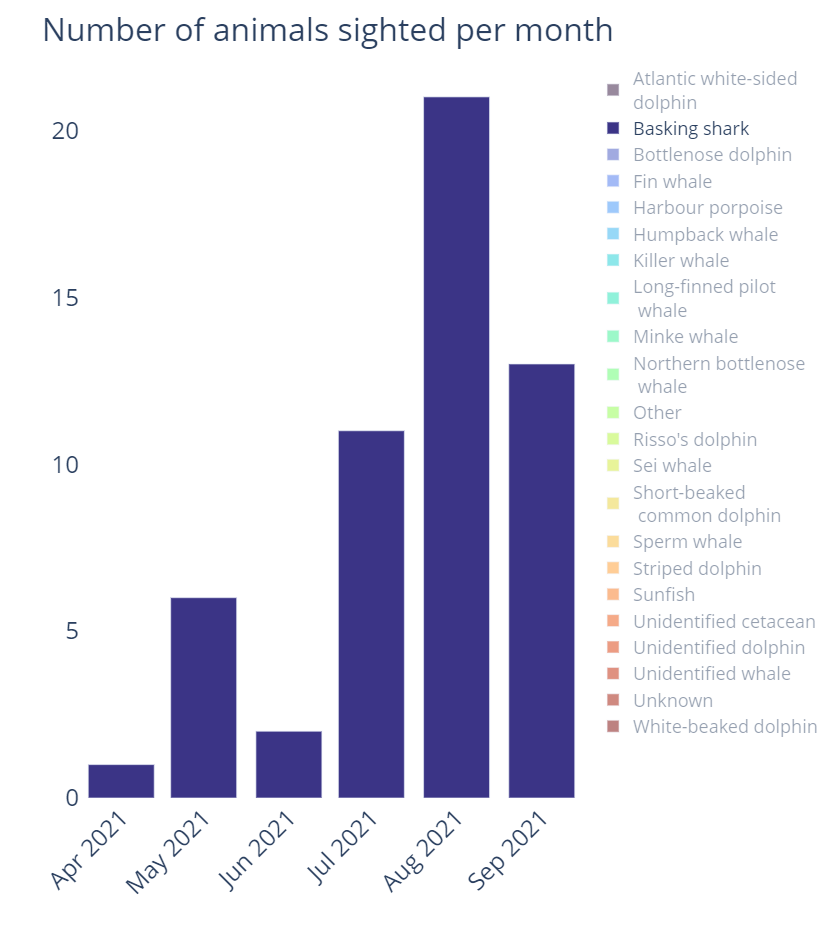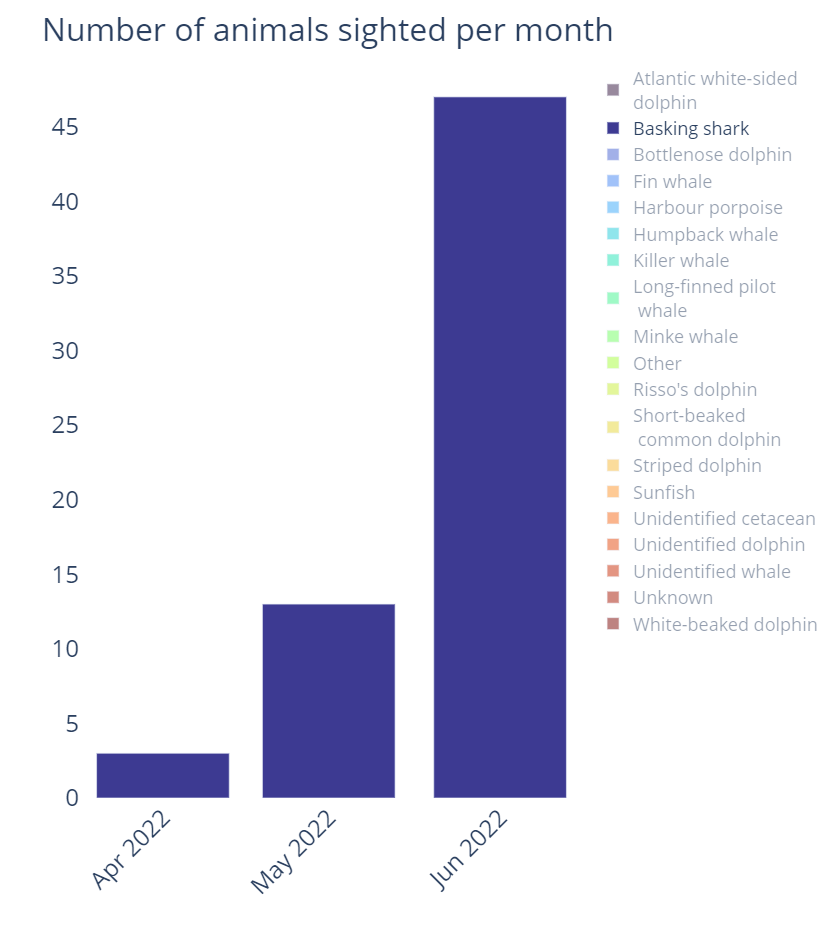Whale Track Spring Sightings Round Up
Back in April, we shared what species you might be lucky enough to spot this Spring - at that point we’d already received over 100 reports through our Whale Track community, so we were excited for what was to come.
Now with over 800 sightings reported from over 200 people, we’re looking at WHAT YOU’VE BEEN SPOTTING.
A total of 6,893 animals from 13 different species were reported, with just over a quarter of reports coming from effort-based boat excursions and the majority from casual encounters. We are happy to see that some of you are using the new watch from land feature on Whale Track, having recorded sightings of harbour porpoise, common dolphin and minke whale.
Along with the usual suspects of common dolphins, harbour porpoises, bottlenose dolphins and minke whales (in order of abundance) we had reports of some of the more elusive species such as Risso’s dolphins, killer whales (See our recent blog), white beaked dolphins, long-finned pilot whales and even a fin whale.
FIN WHALE
Fin whales are widely distributed throughout all major oceans but seem to favour coastal and shelf waters between temperate and polar regions. Little is known about their movements and migration, though it is thought that some seasonal migration does take place.
To the west of the Hebrides is the Rockhall Trough, a ‘migration highway’ for baleen whales and deep diving whales. The west coast of Scotland has a long and diverse coastline with mixing oceanic and coastal currents creating an area of high productivity for fish and plankton, so it stands to reason why we may occasionally get the more unusual species frequenting our waters.
The ‘cliff edge’ of the Rockhall Trough where the continental shelf drops off (left) and the seabed bathymetry off Scotland’s west coast (right)
In the Hebrides, sightings of fin whales are rare but when they do occur, usually it’s during the summer months - they may move into our inshore waters to take advantage of the rich food availability. However, we have had reports this spring of fin whales off the coast of Coll. Whale Track user Dave had a chance encounter of a fin whale while working offshore, observing the whale as it travelled north along the coast of Coll, arching in and out of the water before disappearing from view.
Long finned pilot whales, Loch Scavaig, April 2022 ©Douglas Hudson
PILOT WHALE
Long finned pilot whales are occasionally seen in the Hebrides with sightings being widely distributed. Highly social animals, they are known to congregate in pods sizing from just a few to over 1,000 animals. In the Hebrides, the groups sizes are generally around 20. Unfortunately, pilot whales are a species known for mass stranding, so reports of these animals usually come with a mix of emotions from excitement to concern for their wellbeing.
This year, we had reports of two separate groups of pilot whales both off the Isle of Skye; a pod of up to possibly 40 individuals around Scalpay in March and a smaller group of just 2 individuals in Loch Scavaig in April. Through reported behaviour of these animals, and the knowledge that this species is prone to stranding, the British Divers Marine Life Rescue (BDMLR) were informed so they could be monitored. Luckily, the first group of up to 40 individuals made their way out to deeper waters. Unfortunately, one of the pair sighted in April, was found stranded at the start of May. The Scottish Marine Animal Stranding Scheme (SMASS) was informed so they could obtain samples or conduct a necropsy and try and determine the cause of mortality.
When reporting your sightings, in addition to the essential information such as location, numbers, and species, details of the animal’s behaviour is useful in helping us understand not only what the animals may be using an area for, thus informing conservation measures, but could identify unusual behaviours which are in need of further investigation, like with these pilot whales. Check out our recent blog on whale and dolphin behaviours.
Thank you to everyone who reported their sightings of the pilot whales and helped to monitor the situation and their condition.
If you are concerned for the welfare of a whale, dolphin, porpoise or seal please contact BDMLR.
If you find a dead stranded whale, dolphin or porpoise, please contact SMASS.
BASKING SHARKS
Basking Shark © Fergus Reade (Turus Mara)
Last year, sightings of basking sharks were low, with just over 40 sightings of 54 animals reported through Whale Track throughout the whole year - five of these reports were made between April and May. Already in 2022, numbers are appearing to be higher, with 12 reports of 13 animals having come through between April and May.
Sneaking a peek at June’s reports (which will be included in the summer sightings round up), we already have 26 reports of 47 animals, a massive increase from June 2021 which only had 2 sightings of 2 animals.
Although basking sharks appear to favour coastal waters during spring and summer months and are thought to move into deeper waters during the winter, diving to depths of up to 900 metres to feed on plankton, it is possible the basking sharks were in the area last year, but diving to deeper depths in search of food.
BAIT BALLS
I couldn’t write this blog without mentioning the incredible footage captured by Sharyn Murray, of a feeding frenzy on a bait ball, while out with Staffa Tours at the start of June.
Bait balls occur when fish, as a defence tactic, swarm together into a compact ball shape. They do this in an attempt to protect themselves from predators, hiding behind one another. However, some whales have adapted to take advantage of this strategy and will lunge feed – taking in a huge mouthful of water and prey, after a high-speed propulsion - to take advantage of the compact ball of prey.
This video from Sharyn is an incredible recording of common dolphins, minke whales and seabirds taking advantage of high-density prey, with the common dolphins swimming in circles around the ball of fish, corralling them to the area.








